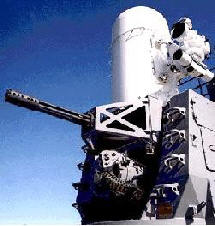|
By Jackie Alan Giuliano, Ph.D.
10th January 2003(ENS)
Few will dispute that our life giving oceans have been harmed by human activities. Fish contain toxic levels of mercury, bottom sediments in harbors around the world are chemical wastelands, dead zones devoid of life are getting larger, fisheries are being exhausted, and consumers are being harmed by the seafood they eat.
Yet even with all this knowledge at hand, the U.S. military, while being marketed by President George W. Bush as the protectors of the world, has been testing weapons by firing radioactive, toxic ammunition made of depleted uranium into prime fishing areas of the coastal waters of the United States.
Depleted uranium (DU) remains radioactive for about
4.5 billion years. That is how old astronomers believe
our solar system is today! When a DU round of
ammunition hits a hard target, as much as 70 percent
of the round burns on impact, creating a huge residue
of fine ceramic uranium dust. Spread by wind or water
the dust can be inhaled or absorbed into humans, plants
and animals, and eventually integrated into the food chain.
|
